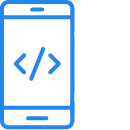

We design and develop high-performance, user-friendly iOS apps that deliver seamless experiences across all Apple devices, ensuring innovation, security, and scalability.
iOS app development enables businesses to create high-performance, secure, and user-friendly applications tailored for Apple devices. With Apple's strict quality standards and seamless ecosystem, apps deliver a superior user experience and reliability.
By leveraging Swift, Objective-C, and advanced frameworks like Core ML, ARKit, and SwiftUI, developers build feature-rich, responsive, and scalable applications. Optimized UI/UX design ensures smooth functionality across iPhones, iPads, and other Apple devices.
Investing in iOS apps provides access to a premium user base, better monetization opportunities, and strong brand credibility. With continuous updates and evolving technologies, businesses can stay ahead in the competitive digital landscape.

iOS is one of the most widely used operating systems, providing access to a vast global user base, ensuring strong market reach and recognition.

Apple prioritizes user security and privacy with features like data encryption, app sandboxing, App Tracking Transparency (ATT), and stringent App Store policies, ensuring maximum protection against cyber threats.

iOS apps are known for their sleek design, smooth performance, and intuitive interfaces, enhancing customer satisfaction and engagement.

iOS follows Apple’s Human Interface Guidelines, ensuring visually appealing, consistent, and user-friendly app designs that enhance usability.

iOS supports cutting-edge technologies such as Augmented Reality (ARKit), Machine Learning (Core ML), Artificial Intelligence, and IoT integration, allowing businesses to create innovative and high-performance applications.

iOS apps integrate effortlessly with Apple’s ecosystem, including iCloud, Apple Pay, Siri, HomeKit, and other services, enhancing user convenience and functionality.
At Neo Coderz, we provide end-to-end iOS app development services, delivering high-performance, secure, and scalable applications for iPhones and iPads. Using Swift, ARKit, Core ML, and AI, we build innovative, future-ready apps with sleek UI/UX, seamless Apple ecosystem integration (iCloud, Apple Pay, Siri), and strict security compliance to protect user data. Our expert team handles everything from custom development and testing to App Store deployment and ongoing maintenance, ensuring a smooth, engaging, and growth-driven mobile experience for businesses of all sizes.

At Neo Coderz, we provide expert iOS app consulting to guide businesses in technology selection, app planning, and market alignment. Our consultants help define a scalable, secure, and high-performance strategy, ensuring your app meets industry standards and business goals. From ideation to launch, we refine your vision and optimize development for long-term success.

At Neo Coderz, we create high-performance, secure, and scalable native iOS apps using Swift and Objective-C. Our team ensures seamless UI/UX, optimized performance, and deep integration with Apple’s ecosystem, including iCloud, Siri, and Apple Pay. From concept to deployment, we deliver fast, reliable, and future-ready solutions for iPhones and iPads.

At Neo Coderz, we craft intuitive, visually stunning, and user-friendly iOS app designs that enhance engagement and usability. Following Apple’s Human Interface Guidelines, we create sleek interfaces with smooth navigation, responsive layouts, and pixel-perfect graphics. Our design process focuses on user behavior, accessibility, and brand consistency, ensuring a seamless and delightful experience across all Apple devices.

At Neo Coderz, we provide seamless iOS app migration and maintenance services to ensure your app remains updated, secure, and high-performing. We assist in migrating apps to the latest iOS versions, enhancing compatibility, and optimizing performance. Our maintenance services include bug fixes, security updates, feature enhancements, and App Store compliance to keep your app running smoothly and efficiently.

At Neo Coderz, we offer seamless iOS app upgradation services, ensuring your app stays compatible with the latest iOS versions, devices, and features. We enhance performance, security, and user experience by integrating new functionalities, optimizing UI/UX, and ensuring compliance with App Store guidelines. Stay ahead with a modern, high-performing, and future-ready iOS app.

At Neo Coderz, we ensure your iOS app delivers a flawless, secure, and high-performance experience through rigorous Quality Assurance (QA) and testing. Our experts conduct functional, performance, security, and usability testing to detect and resolve bugs, optimize speed, and ensure seamless compatibility across iOS devices. With a focus on App Store compliance and user experience, we guarantee a reliable, bug-free, and fully optimized app.

At Neo Coderz, we provide seamless iOS app API integration to enhance functionality, connectivity, and user experience. Our experts integrate third-party APIs, cloud services, payment gateways, social media platforms, and Apple ecosystem features like Siri, Apple Pay, and iCloud. We ensure secure, efficient, and scalable API solutions that optimize app performance and streamline data exchange.
Whether it's a single expert or an entire team, we provide the right professionals to build your digital software solution with precision and excellence.
Our structured, step-by-step approach ensures a seamless and efficient project execution, starting with a deep understanding of your requirements and culminating in the delivery of high-quality, customized IT solutions designed to drive your business forward.
We take the time to listen to our clients to fully understand their vision and requirements. We meticulously review all project specifications and files, ensuring no detail or feature is overlooked. Once we have a clear understanding, we make thoughtful suggestions for improvements before moving forward to the next stage.
Using the information gathered from the previous stage and considering the website’s SEO strategy, we lay the foundation or roadmap for the site architecture. This includes creating the sitemap and wireframes for the pages, ensuring a robust structure that supports both user experience and search engine optimization.
At this stage, we at Neo Coderz create the visual style of the website, ensuring it aligns with the product’s identity. We explore the overall mood, including fonts, color palette, and usability. Several design prototypes are created, and once everything is ready for presentation, we collaborate with you to define the best option to move forward with.
Failing to plan is planning to fail. Before we begin coding, we thoroughly review the user stories to define the application’s functionality. We then select the appropriate framework, set up the development environment, and structure the database. Finally, we convert the design into semantically hand-coded, functional HTML pages.
Our rigorous testing and QA process ensures your website delivers a flawless and seamless user experience. We meticulously inspect every pixel, call to action, spelling, and code validation. By testing across multiple browsers, devices, and operating systems, we identify and resolve all issues before launch.
Hello World! The launch of any product is always an exciting and memorable moment, and your website is no different. On Launch Day, the focus is on making sure everything goes smoothly as your website goes live. Once every test is passed, we will make it available to millions of users on the internet.
In today’s competitive business landscape, every client seeks a unique and high-performing application for their enterprise. PHP stands out as a powerful platform for delivering practical and efficient solutions.
We leverage the full potential of PHP to ensure your website goes beyond basic development. Our approach provides a comprehensive web solution—optimized, functional, and designed to enhance your online presence, helping you achieve success.

Our team consists of highly skilled PHP developers and implementation experts.

We build websites and web applications that meet the highest quality benchmarks.

We deliver tailor-made solutions to fit both simple and complex business needs.

Our agile development process ensures flexibility for future updates while staying within your budget.

We follow advanced technologies and industry standards to deliver bug-free, high-quality solutions.

We maintain complete transparency in workflow and pricing, ensuring trust and clarity in every step.